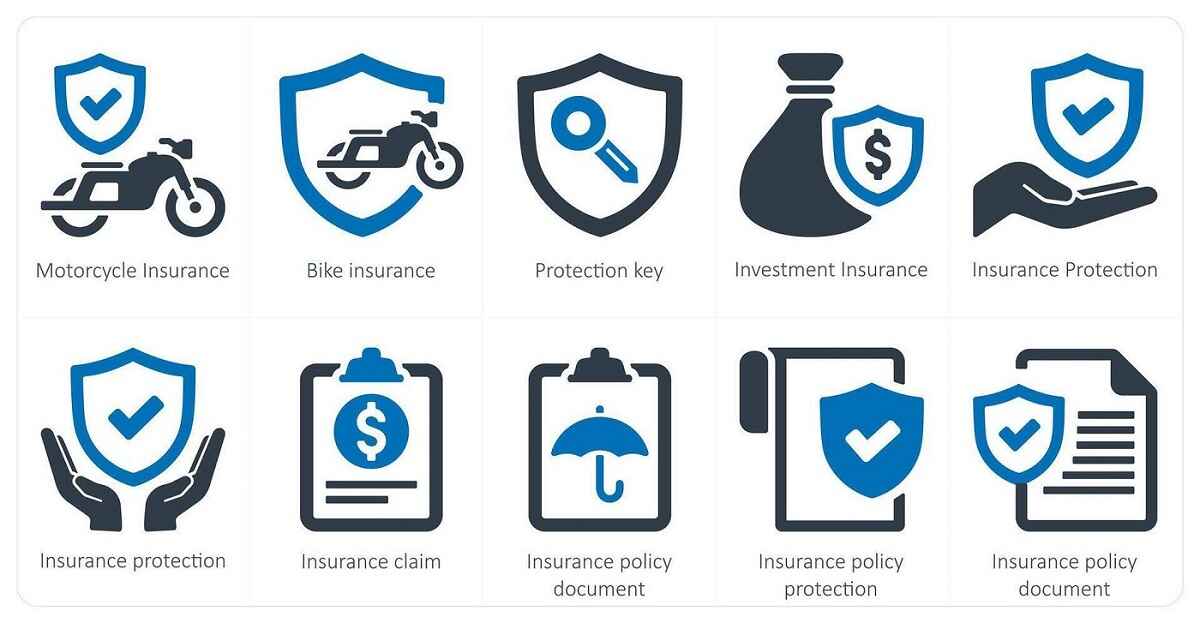
Get your 2 wheeler insured in 5 minutes
Bike Insurance
Bike insurance , also known as motorcycle insurance or two-wheeler insurance, is a type of insurance policy designed to provide financial protection against damages or losses associated with owning and operating a motorcycle, scooter, or other two-wheeled vehicles. It offers coverage for various risks and uncertainties that riders may encounter on the road, including accidents, theft, vandalism, natural disasters, and third-party liabilities.
Bike insurance policies may also offer additional coverage options or add-on covers to enhance the basic coverage, such as personal accident cover for the rider, pillion rider cover, roadside assistance, zero depreciation cover, and more.
Bike insurance is mandatory by law in many countries, including India, to legally ride a motorcycle on public roads. It helps ensure financial security and peace of mind for bike owners by providing compensation and support in case of accidents, theft, or other unforeseen events.
Overall, bike insurance plays a crucial role in protecting riders, their bikes, and third parties from potential financial losses and liabilities, making it an essential investment for all motorcycle owners.

Accidental Cover

Theft Cover

Third Party Cover
Bike insurance terminologies
- Premium: The amount paid by the policyholder to the insurance company in exchange for bike insurance coverage. Premiums can be paid annually, semi-annually, quarterly, or monthly.
- Policy: The legal contract between the insurance company and the policyholder that outlines the terms and conditions of the bike insurance coverage, including coverage limits, deductibles, exclusions, and premium payment details.
- Insured Declared Value (IDV): The maximum amount payable by the insurance company in case of total loss or theft of the insured bike. It represents the current market value of the bike and is used to calculate the premium.
- Deductible: The amount that the policyholder agrees to pay out of pocket before the insurance company covers the remaining cost of a claim. Higher deductibles usually result in lower premiums.
- Claim: A formal request made by the policyholder to the insurance company for compensation or coverage of damages or losses as per the terms of the bike insurance policy.
- No Claim Bonus (NCB): A discount offered by the insurance company on the premium for every claim-free year. NCB rewards policyholders for safe riding habits and can lead to significant savings on premiums over time.
- Endorsement: A formal amendment or modification to the terms and conditions of the bike insurance policy. Endorsements may be requested by the policyholder to add or remove coverage, change policy details, or update information.
- Exclusions: Specific circumstances, situations, or types of damages that are not covered by the bike insurance policy. Exclusions are listed in the policy document and may vary depending on the insurer and policy type.
- Add-On Covers: Optional additional coverages or riders that policyholders can purchase to enhance the basic bike insurance coverage. Add-ons offer extra protection against specific risks or provide additional benefits beyond the standard policy coverage.
- Renewal: The process of extending the term of the bike insurance policy by paying the premium for another policy period. Bike insurance policies typically need to be renewed annually to maintain continuous coverage.
Understanding these bike insurance terminologies is essential for policyholders to make informed decisions, understand their coverage, and navigate the insurance process effectively.
What are the key features of bike insurance policy?

Key Features of Bike Insurance Policy:
A bike insurance policy typically includes the following key features:
- Own Damage Coverage: Provides coverage for damages to the insured bike due to accidents, collisions, theft, fire, vandalism, and other perils. It reimburses the policyholder for repair or replacement costs of the bike.
- Third-Party Liability Coverage: Provides protection against financial liabilities arising from damages or injuries caused to third parties (other individuals, vehicles, or property) in accidents involving the insured bike. It covers legal expenses, compensation payouts, and property damage costs.
- Add-On Covers: Optional additional coverages or riders that policyholders can purchase to enhance the basic bike insurance coverage. Add-ons offer extra protection against specific risks or provide additional benefits beyond the standard policy coverage.
- No Claim Bonus (NCB): A discount offered by the insurance company on the premium for every claim-free year. NCB rewards policyholders for safe riding habits and can lead to significant savings on premiums over time.
- Cashless Claims: Many insurers offer the facility of cashless claims, allowing policyholders to get their bikes repaired at network garages without paying upfront for the repair costs. The insurer settles the repair bills directly with the garage.
- Personal Accident Cover: Provides compensation in case of accidental death or permanent disability of the policyholder due to a bike accident. The coverage amount is usually fixed and specified in the policy.
- 24/7 Assistance: Some bike insurance policies offer round-the-clock assistance services, including roadside assistance, towing, emergency repairs, and accommodation arrangements in case of breakdowns or accidents.
- Online Policy Management: Many insurers provide online platforms or mobile apps for policyholders to manage their bike insurance policies conveniently. Policyholders can renew policies, file claims, track claim status, and access policy documents digitally.
These key features make bike insurance policies essential for protecting riders, their bikes, and third parties from potential financial losses and liabilities, providing peace of mind on the road.
What are the types of bike insurance policies?
Types of Bike Insurance Policies:
Bike insurance policies are primarily categorized into two main types based on the coverage they provide:
- Third-Party Liability Insurance: This type of bike insurance policy provides coverage for liabilities arising from damages or injuries caused to third parties (other individuals, vehicles, or property) in accidents involving the insured bike. It is mandatory by law in many countries, including India, to legally ride a bike on public roads. Third-party liability insurance does not cover damages to the insured bike or injuries sustained by the policyholder.
- Comprehensive Insurance: Also known as package policy or own damage insurance, comprehensive bike insurance offers broader coverage by combining third-party liability coverage with coverage for damages to the insured bike due to accidents, collisions, theft, fire, vandalism, natural disasters, and other perils. It provides comprehensive protection for the policyholder, the insured bike, and third parties involved in accidents.
In addition to these main types, bike insurance policies may offer various add-on covers or riders that policyholders can purchase to enhance the basic coverage. Add-ons provide additional protection against specific risks or offer extra benefits beyond the standard policy coverage.
Choosing the right type of bike insurance policy depends on factors such as the coverage requirements, budget, and individual preferences of the policyholder. While third-party liability insurance fulfills the legal requirement, comprehensive insurance provides comprehensive protection and peace of mind on the road.

Why do we need bike insurance?
Bike insurance is essential for several reasons:
- Legal Requirement: In many countries, including India, having bike insurance is mandatory by law to legally ride a bike on public roads. Third-party liability insurance is compulsory to cover liabilities arising from damages or injuries caused to third parties in accidents involving the insured bike.
- Financial Protection: Bike insurance provides financial protection against unexpected expenses arising from accidents, theft, fire, vandalism, and other perils. It covers repair or replacement costs of the insured bike, medical expenses for injuries sustained by the policyholder, and liabilities towards third parties involved in accidents.
- Peace of Mind: Having bike insurance offers peace of mind and security on the road. It protects riders from the financial burden of repairing or replacing their bikes in case of accidents or unforeseen events. With insurance coverage in place, riders can focus on enjoying their rides without worrying about potential risks and uncertainties.
- Risk Management: Bike insurance helps mitigate risks associated with owning and riding a bike. It transfers the financial risk of accidents, theft, and other damages from the policyholder to the insurance company. By paying a relatively small premium, riders can safeguard themselves against potentially significant financial losses due to unforeseen events.
- Legal Compliance: Riding a bike without insurance not only violates legal requirements but also exposes riders to legal penalties, fines, and liabilities. In case of accidents, uninsured riders may be held personally liable for damages and compensation payouts, leading to financial and legal consequences.
Overall, bike insurance is an essential investment for bike owners, offering legal compliance, financial protection, peace of mind, and risk management benefits. It ensures that riders are adequately covered against potential risks and uncertainties on the road, allowing them to ride with confidence and security.
Third party bike insurance vs comprehensive bike insurance
When it comes to bike insurance, there are two main types of policies available: third-party insurance and comprehensive insurance. Let's compare the two:
- Third-Party Bike Insurance:
- Provides coverage for liabilities arising from damages or injuries caused to third parties (other individuals, vehicles, or property) in accidents involving the insured bike.
- Mandatory by law in many countries, including India, to legally ride a bike on public roads.
- Does not cover damages to the insured bike or injuries sustained by the policyholder.
- Offers basic protection at a lower cost compared to comprehensive insurance.
- Recommended for budget-conscious riders who prioritize legal compliance and minimum coverage requirements.
- Comprehensive Bike Insurance:
- Combines third-party liability coverage with coverage for damages to the insured bike due to accidents, collisions, theft, fire, vandalism, natural disasters, and other perils.
- Offers broader and more extensive coverage compared to third-party insurance.
- Provides financial protection for the policyholder, the insured bike, and third parties involved in accidents.
- Offers peace of mind and security on the road by covering a wide range of risks and uncertainties.
- Recommended for riders who want comprehensive protection against potential financial losses and liabilities.
Choosing between third-party and comprehensive bike insurance depends on factors such as coverage requirements, budget, and individual preferences. While third-party insurance fulfills the legal requirement and offers basic protection, comprehensive insurance provides comprehensive coverage and peace of mind on the road.

Coverage and not coverage in bike insurance policy
A bike insurance policy provides coverage for certain risks and perils, while also specifying exclusions or circumstances under which coverage may not apply. Let's understand what is covered and not covered in a typical bike insurance policy:
-
Coverage:
- Own Damage: Coverage for damages to the insured bike due to accidents, collisions, theft, fire, vandalism, natural disasters, and other insured perils.
- Third-Party Liability: Coverage for liabilities arising from damages or injuries caused to third parties (other individuals, vehicles, or property) in accidents involving the insured bike.
- Personal Accident Cover: Compensation for accidental death or permanent disability of the policyholder due to a bike accident.
- Additional Covers/Add-Ons: Optional coverages or riders that policyholders can purchase to enhance the basic policy coverage, such as zero depreciation cover, roadside assistance, engine protection, etc.
- General Wear and Tear: Damages resulting from general wear and tear, aging, deterioration, or mechanical breakdown of the bike.
- Negligence: Damages caused due to negligence or carelessness of the policyholder, such as driving under the influence of alcohol or drugs, unauthorized use of the bike, etc.
- Racing or Illegal Activities: Damages occurring while participating in racing activities or illegal acts with the insured bike.
- Consequential Losses: Indirect or consequential losses not directly resulting from insured perils, such as loss of income, loss of market value, or loss of use of the bike.
- Excluded Perils: Damages caused by specific perils or events explicitly excluded from coverage in the policy document, such as war, nuclear risks, acts of terrorism, etc.
It's essential for policyholders to review the coverage and exclusions in their bike insurance policy carefully to understand the scope of coverage, obligations, and limitations. Being aware of what is covered and not covered helps policyholders make informed decisions and avoid claim disputes or rejections.
Add on covers
Add-On Covers in Bike Insurance:
Add-on covers, also known as riders or endorsements, are optional additional coverages that policyholders can purchase to enhance the basic coverage provided by their bike insurance policy. These add-ons offer extra protection against specific risks or provide additional benefits beyond the standard policy coverage. Let's explore some common add-on covers available in bike insurance:
- Zero Depreciation Cover: Provides coverage for the full value of repairs or replacements without considering depreciation. It ensures that policyholders receive higher claim payouts for damages to bike parts that depreciate over time, such as plastic, rubber, and fiberglass components.
- Engine Protection: Covers damages to the bike's engine and gearbox due to water ingression, hydrostatic lock, oil leakage, and consequential damages. It offers financial protection against costly repairs or replacements of critical engine components.
- Roadside Assistance: Offers 24/7 assistance services, including towing, emergency repairs, fuel delivery, battery jump-start, and flat tire assistance. It provides peace of mind and support to policyholders in case of breakdowns, accidents, or emergencies on the road.
- Personal Accident Cover for Pillion Rider: Extends personal accident cover to the pillion rider, providing compensation for accidental death or permanent disability due to a bike accident. It ensures financial protection for both the policyholder and the pillion rider in case of unfortunate events.
- Consumables Cover: Covers the cost of consumable items used during repairs or replacements, such as nuts, bolts, screws, engine oil, lubricants, brake fluids, etc. It helps policyholders avoid out-of-pocket expenses for routine maintenance and minor repairs.
- Key Replacement Cover: Covers the cost of replacing lost, stolen, or damaged keys of the insured bike. It provides convenience and financial assistance to policyholders in case of key-related emergencies or incidents.
- Return to Invoice (RTI) Cover: Offers coverage for the invoice value of the bike in case of total loss or theft. It ensures that policyholders receive the original invoice amount of the bike, including registration fees and road tax, in case of irrecoverable loss or theft.
Add-on covers allow policyholders to customize their bike insurance policy according to their specific needs, preferences, and budget. By adding relevant add-ons, policyholders can enhance their coverage, maximize protection, and enjoy greater peace of mind on the road.
Factors affecting bike insurance premium
The premium of a bike insurance policy is determined based on various factors that influence the risk profile of the insured bike and the policyholder. Understanding these factors can help policyholders make informed decisions and manage their insurance costs effectively. Here are the key factors affecting bike insurance premium:
- Bike's Insured Declared Value (IDV): The IDV represents the current market value of the insured bike and serves as the maximum sum insured under the policy. Higher IDV leads to higher premiums, while lower IDV results in lower premiums.
- Bike's Make, Model, and Variant: The make, model, variant, and engine capacity of the bike significantly impact the premium. High-performance bikes, luxury bikes, and imported bikes attract higher premiums due to their higher repair or replacement costs.
- Age of the Bike: Newer bikes generally have higher premiums compared to older bikes due to their higher market value and repair costs. Depreciation also affects the premium, with older bikes having lower premiums due to lower IDV.
- Location of Registration: The geographical location where the bike is registered influences the premium. Areas with higher traffic density, crime rates, and accident rates may have higher premiums to reflect the increased risk of accidents, thefts, or damages.
- Policyholder's Age and Experience: The age and driving experience of the policyholder affect the premium. Younger and inexperienced riders may face higher premiums due to their higher risk of accidents, while older and experienced riders may qualify for lower premiums.
- Claim History: The policyholder's claim history plays a significant role in determining the premium. A history of frequent claims or accidents may lead to higher premiums, while a claim-free record may qualify for discounts or lower premiums through the No Claim Bonus (NCB).
- Additional Covers/Add-Ons: Opting for add-on covers or riders to enhance the basic policy coverage increases the premium. The cost of add-ons varies depending on the coverage provided and the insurer's pricing strategy.
- Voluntary Deductible: Choosing a voluntary deductible, which is the amount the policyholder agrees to bear in case of a claim, can lower the premium. Higher voluntary deductibles result in lower premiums, but policyholders must be prepared to pay the deductible amount at the time of claim.
By considering these factors and comparing quotes from multiple insurers, policyholders can find the most suitable bike insurance policy that offers adequate coverage at a competitive premium.
Documents reqired to get bike insurance
When applying for bike insurance, policyholders need to provide certain documents to complete the application process and purchase the insurance policy. These documents help insurers verify the identity, ownership, and other relevant details of the insured bike and the policyholder. Here are the typical documents required to get bike insurance:
- Vehicle Registration Certificate (RC): A copy of the bike's registration certificate (RC) is required to confirm the ownership details, vehicle identification number (VIN), engine number, and other particulars of the insured bike.
- Previous Insurance Policy Documents: If renewing an existing bike insurance policy, policyholders need to provide a copy of the previous policy documents to transfer the accumulated No Claim Bonus (NCB) and claim history to the new policy.
- Identity Proof: Policyholders need to provide a valid proof of identity, such as Aadhaar card, PAN card, passport, voter ID card, or driver's license, to verify their identity and personal details.
- Address Proof: A valid proof of address, such as Aadhaar card, utility bill, passport, voter ID card, or driving license, is required to verify the residential address of the policyholder.
- Vehicle Inspection Report: In some cases, insurers may require a vehicle inspection report to assess the condition and roadworthiness of the insured bike before issuing the insurance policy.
- Vehicle Purchase Invoice: A copy of the purchase invoice or sales receipt may be required to verify the purchase price, date of purchase, and other details of the insured bike, especially for new bikes.
- Bank Account Details: Policyholders need to provide their bank account details for premium payment and refund purposes, especially for online payments and electronic fund transfers.
It's essential for policyholders to ensure that all required documents are accurate, valid, and up to date to avoid delays or complications in the insurance application process. Providing complete and authentic documents helps expedite the issuance of the bike insurance policy and ensures smooth coverage.
How to file a bike insurance claim?
Filing a bike insurance claim involves a few straightforward steps to report damages, losses, or incidents covered under the insurance policy and request compensation or coverage from the insurance company. Here's a general overview of the process:
- Notify the Insurer: Inform the insurance company as soon as possible after the occurrence of an incident or damage to the insured bike. Contact the insurer's customer service helpline or claims department to initiate the claim process.
- Provide Details: Provide accurate and detailed information about the incident, including the date, time, location, nature of the damage or loss, and any relevant circumstances or factors. Be prepared to share your policy details, contact information, and other relevant documentation.
- Fill Claim Form: Complete the required claim form provided by the insurance company. Provide all necessary details and attach supporting documents, such as the copy of the insurance policy, vehicle registration certificate (RC), identity proof, accident report, repair estimates, etc.
- Submit Documents: Submit the claim form along with the supporting documents to the insurance company either online through the insurer's website or mobile app, or offline by visiting the nearest branch office or contacting the claims department directly.
- Vehicle Inspection: In case of damages to the insured bike, the insurance company may arrange for a vehicle inspection to assess the extent of damages, verify the claim details, and estimate repair costs. Cooperate with the insurer's surveyor or authorized representative during the inspection process.
- Claim Settlement: Once the claim documents are submitted and verified, the insurance company will process the claim and determine the claim amount based on the policy coverage, deductibles, depreciation, and other applicable factors. The claim settlement may involve reimbursement for repair costs, cashless repair at network garages, or compensation for total loss or theft.
- Claim Disbursement: After the claim is approved and settled, the insurance company disburses the claim amount to the policyholder's bank account or directly to the repair service provider, as per the agreed terms and conditions of the policy.
- Claim Status Updates: Stay in touch with the insurance company for updates on the claim status and settlement process. Follow up if there are any delays or discrepancies in the claim processing to ensure timely resolution.
By following these steps and providing accurate information and documentation, policyholders can expedite the bike insurance claim process and receive timely compensation or coverage for damages, losses, or incidents covered under the policy.
Documents required for filing a bike insurance claim
When filing a bike insurance claim, policyholders need to provide certain documents to support their claim and facilitate the claim processing by the insurance company. These documents help verify the incident, assess the damages or losses, and determine the eligibility for claim settlement. Here are the typical documents required for filing a bike insurance claim:
- Claim Form: Complete the claim form provided by the insurance company, providing accurate details about the incident, damages, and other relevant information.
- Insurance Policy Documents: Provide a copy of the bike insurance policy documents, including the policy certificate, schedule, and terms and conditions, to verify coverage details and policy validity.
- Vehicle Registration Certificate (RC): Submit a copy of the bike's registration certificate (RC) to confirm ownership details, vehicle identification number (VIN), engine number, and other particulars.
- Identity Proof: Provide a valid proof of identity, such as Aadhaar card, PAN card, passport, voter ID card, or driver's license, to verify the identity of the policyholder.
- Accident Report: If the claim is related to an accident, provide an accident report or FIR (First Information Report) from the police or relevant authorities, detailing the circumstances, date, time, and location of the accident.
- Repair Estimates: Obtain repair estimates or quotations from authorized garages or repair service providers detailing the estimated costs of repairing the damages to the insured bike.
- Photographs/Videos: Provide photographs or videos of the damaged bike and the accident scene, if available, to document the extent of damages and support the claim assessment process.
- Other Relevant Documents: Depending on the nature of the claim, additional documents may be required, such as medical reports for personal injury claims, theft reports for stolen bike claims, invoices for replaced parts, etc.
Policyholders should ensure that all required documents are complete, accurate, and submitted within the stipulated time frame to avoid delays or complications in the claim processing. Providing comprehensive documentation helps expedite the claim settlement process and ensures timely compensation or coverage for damages or losses incurred.

Tips to avoid bike insurance claim rejection
Claim rejection can be frustrating and inconvenient for policyholders, leading to financial losses and disputes with the insurance company. To minimize the risk of claim rejection and ensure smooth claim processing, here are some essential tips to follow:
- Understand Policy Coverage: Familiarize yourself with the coverage details, terms, and conditions of your bike insurance policy to ensure that the incident or damage is covered under the policy. Review the policy document carefully to avoid claiming for exclusions or non-covered perils.
- Provide Accurate Information: When applying for insurance or filing a claim, provide accurate and truthful information about your bike, personal details, incident, damages, and other relevant information. Misrepresentation or withholding information can lead to claim rejection.
- Timely Reporting: Notify the insurance company promptly after the occurrence of an incident or damage to your bike, as delaying the claim reporting can raise suspicion and lead to claim rejection. Follow the specified reporting procedures and timelines mentioned in the policy.
- Document Everything: Document the incident, damages, and related details thoroughly by taking photographs, videos, and written notes. Keep copies of all relevant documents, such as the insurance policy, claim form, accident report, repair estimates, and communication with the insurer.
- Cooperate with Insurer: Cooperate fully with the insurance company during the claim assessment, inspection, and investigation process. Provide requested documents, information, and access to the damaged bike for inspection by the insurer's surveyor or authorized representatives.
- Follow Claim Procedures: Adhere to the claim procedures and guidelines specified by the insurance company. Fill out the claim form accurately, provide all required documents, and follow up on the claim status regularly to ensure timely processing and settlement.
- Avoid Fraudulent Practices: Refrain from engaging in fraudulent activities, such as providing false information, exaggerating damages, staging accidents, or tampering with evidence. Insurance fraud can lead to claim rejection, policy cancellation, and legal consequences.
- Seek Legal Advice: If you believe your claim has been unfairly rejected or disputed by the insurance company, seek legal advice from a qualified professional.